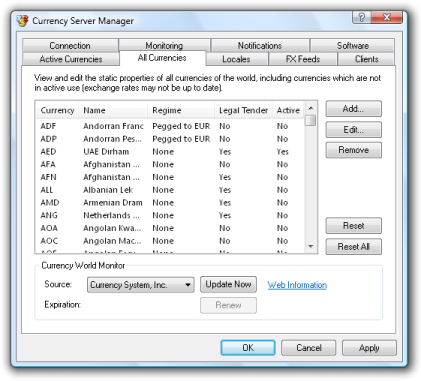Currency World Monitor
In addition to supporting currency exchange rate updates
via different providers of exchange rate
data, Currency Server can automatically check several
other types of data, including:
- Names, codes, smallest units and other properties of all currencies of the world
- Status of European Economic and Monetary Union (EMU) currencies
This additional non-exchange rate data is maintained and
provided by Currency System both to its software customers and as
part of its managed
services.

Updates to Static Currency Properties
Exchange rates are not the only currency properties which change over time.
For example, when a state joins the European Economic
and Monetary Union (EMU), its national currency may become a sub-unit of the
euro (during a transition phase which may last months or years) before being
replaced by the euro. During this timeframe the software must employ a triangulation procedure to convert to
and from the national currency. Also, countries themselves may change name (and
their currency with them), or split into two or more new countries (with new
currencies), or form new unions with other countries, or simply replace an old
currency with a new one.
While exchange rate updates occur at least once every weekday, modifications
to "static" currency properties (like changes to currency names, or EMU status changes) are considerably less frequent, i.e. they occur about once every few
months. Nevertheless, it can be easy to lose oversight of such changes, and
longer lists of currencies can quickly get obsolete even if they are not
contaminated with old data (e.g. wrong currency names, inclusion of currencies
which ceased to be legal tender, etc.) to begin with, as is often the case with
lists which can be found on the internet and which are sometimes just a sum of
unverified data from different sources.
Once a week or if necessary to process new data, and only during exchange
rate data updates, Currency Server also verifies whether non-exchange rate
updates are available from Currency System as part of its Currency World Monitor
service. If this is the case, the new data is loaded (but not applied) and an
appropriate notification is issued. The message provides information about the
nature of the change (e.g. a currency joining the EMU, or ceasing to be legal
tender, etc.) and instructions on how to apply the change (e.g. by clicking
Reset All in the All Currencies tab and/or
Reset EMU in the Active Currencies tab of Currency Server Manager). If this
update process fails, the software continues to function normally (updates can
still be applied manually, if so desired).
Worldwide Currency Data Updates
Currency System is a licensee of ISO 4217 currency codes
and is immediately notified by the ISO 4217 Maintenance Agency whenever a change
occurs. Currency System also actively monitors other changes such as the status of the EMU, internationalization trends, new currency
symbols, rounding procedures, etc. This information is incorporated into the
Currency Server software at compile time. Additionally, updates to this static data are made
available as part of the Currency World Monitor service provided by Currency
System.
Currency Server specifically supports the following change scenarios for all
currencies of the world (not just the currencies listed as active):
- New currency is introduced
- Currency ceases to be legal tender
- Change of regime status (e.g. EMU)
- Currency changes code
- Change of other currency properties (e.g. smallest unit, localized
names, symbols)
These special updates are independent of exchange rate updates (which are
provided by different sources), and are provided
by Currency System as part of the Currency World Monitor service.
EMU Currency Data Updates
Currency Server specifically supports the following change scenarios for
currencies of the European Economic and Monetary Union:
- Currency joins EMU (conversion rate is locked, triangulation begins)
- Currency is replaced by euro (ceasing to be legal tender)
- Currency abandons EMU (triangulation ceases, fluctuating exchange
rates as provided by external sources)
These special updates are independent of exchange rate updates (which are
provided by different sources), and are provided
by Currency System as part of the Currency World Monitor service.
If the EMU status of a currency has changed since the previous update an
appropriate notification
is issued by the software, advising to select Reset EMU in the Active Currencies tab, so that the new list of EMU currencies and the
corresponding triangulation settings can be applied as appropriate. No changes
are applied until Reset EMU is selected. The Reset EMU function
includes an option to retain currencies which have ceased to be legal tender, if
data for such currencies is available.
|